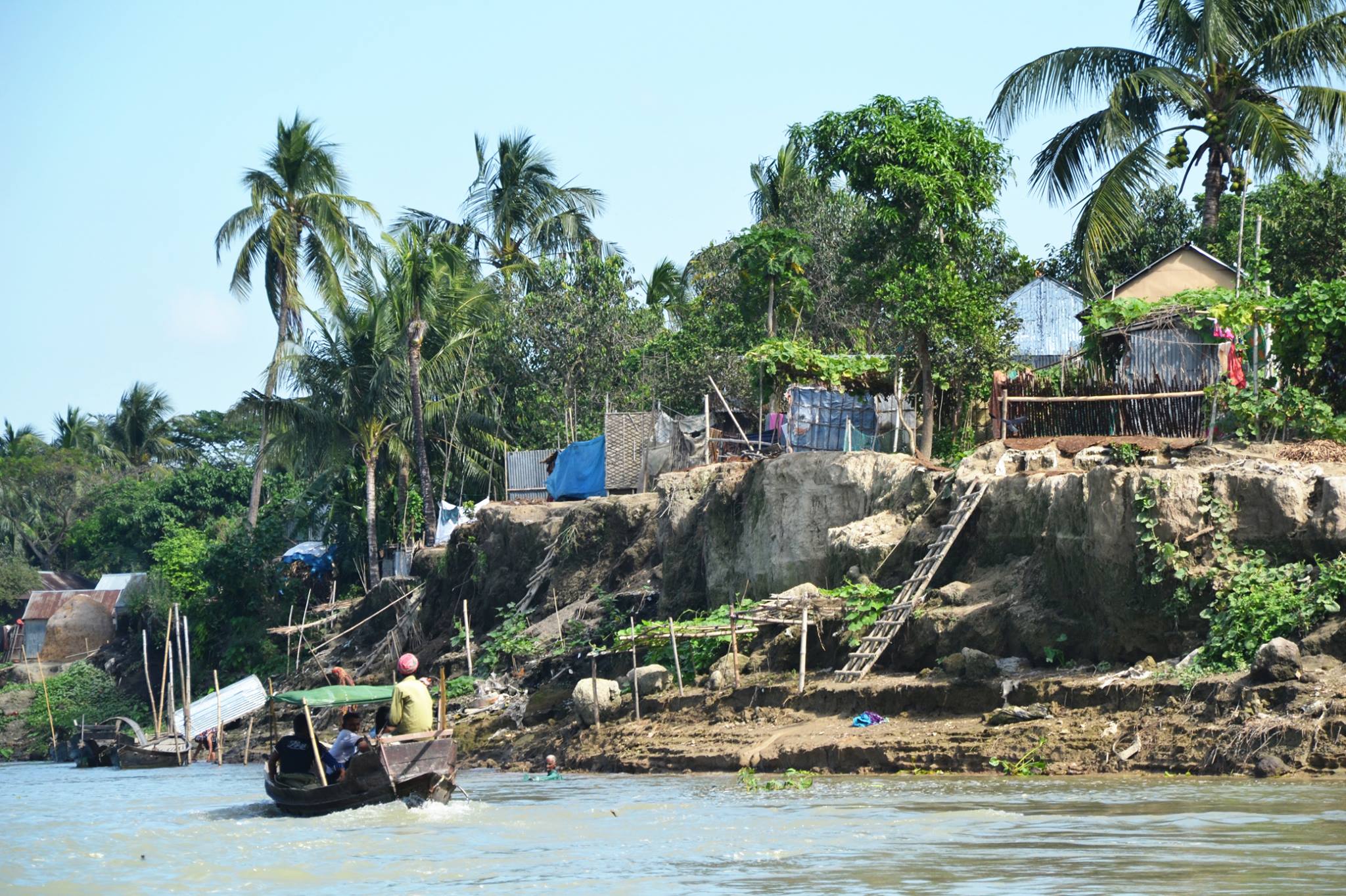Article /
When the disaster strikes: Gendered (im)mobility in Bangladesh

Introduction
The uneven impacts on women from global environmental changes put gender at the frontline of all three 2015 climate agendas. Empirical evidence illustrating gendered vulnerabilities to environmental stress will be crucial to the development of more robust policy frameworks. These scenarios include immobility as vulnerable populations may be unable to escape environmental risks.
People are known to migrate away from environmentally risky locations and situations, but some may also be unable to move. Trapped Populations is a concept put forward as an effective policy tool to safeguard involuntarily immobile vulnerable people in a climate changed world. Gendered vulnerability through social immobility will be imporant to further the conceptualisation of Trapped Populations.
This study investigates gendered (im)mobility during cyclone strikes in Bangladesh. People explained that failing to evacuate to the cyclone shelters when a disaster strikes was common (especially among women). Gender played a significant role in the evacuation decision-making process by facilitating or constraining people’s mobility. For example, masculine roles were expected to be brave and protective which left men feeling anxious and worried about failing to protect or save their family members. Meanwhile, female ‘mobility’ could be risky and at times needed to be limited and controlled. Women’s mobility therefore ended up being constrained to the home. In other words, when the disaster strikes, everyone did not have the same ability to move. Drawing on a Q-based Discourse Analysis, this article supports an explanation of why people (and often women due to power relations) fail to evacuate when a cyclone strikes.
*Download the full publication from the right-hand column. The key messages from the publication are provided below. See the full text for much more detail.
Method
Most investigations exploring gendered disasters and vulnerabilities in Bangladesh have tended to present overly simplistic linkages or neglected vulnerability differences due to socio-economic status, age, religion, social background, marginalisation and stigma. This Q-based Discourse Analysis explores discursive values around cyclone evacuation in Bangladesh and whether people felt constrained, socially immobile or ‘trapped’ by their gendered subjectivity. Q-methodology is a way to encapsulate people’s subjectivities around a topic or within a social or geographical group.
15 different discourse (or factor) groups were identified in three study sites (Dalbanga South, Mazer Char and Gabtola), drawing on 40 Q-statements generated from 100 qualitative field quotes gathered through a diverse set of research sessions conducted between 2014 and 2015.
Results
The findings reveal gendered subjective reasonings around why some people should evacuate while others ought to stay behind. The following 15 different discourse groups were identified in the three study sites wherof a remarkable 14 were predominantly associated with either female or male participants.
The following five discourse groups were identified in Dalbanga South (a coastal village that reported lacking disaster preparedness measures:
- The planner (female): The planner clearly separated the home and shelter as unsafe and safe spaces.
- The troubled (male): The troubled expressed diverse fears related to shelter evacuation and the cyclone strikes. Despite their fears around evacuation, The troubled strongly emphasised that everyone, women and men, had the right to evacuate and seek safety in the cyclone shelter.
- The protector (male): The protector shared some values with The troubled by outlining the right for everyone to seek shelter. The protector, however, added the importance of disaster training and that a man must protect his whole family (not just himself).
- The follower (female): The follower brought up the importance of natural early warning messages. According to The follower, it would be wrong of a man to evacuate and leave his wife behind. A husband’s first priority must be to protect his wife.
- The stayer (female): The stayer was certain that women were unsafe in the cyclone shelters – a woman belongs at home. The lack of safety in the shelter is related to the crowds that increased risks to females.
*Watch the video above the article to hear testimony from this region.
In Mazer Char four discourse groups were detected (a coastal island cut off from the mainland during cyclone strikes as people could not reach the mainland by boat):
- The cautious (female): The cautious explained how important early warning systems are for people as they anticipate the approaching dangers.
- The realist (male): The realist thought the main issue was the lack of space in the shelter. It was not that people did not want to evacuate, but that the limited space prevented them from trying.
- The believer (female): The believer had to evacuate to the shelters for their own safety. Evacuating was the right thing to do so one should listen to villagers or accommodate around things making sure to seek shelter when encouraged. In the end however, The believer explained, who was to live and who was to die would all be up to God’s will.
- The anxious (female): The anxious explained that they sometimes did not even evacuate when told to by the disaster preparedness volunteer. The anxious expressed pure terror around what could happen to them during the cyclone strikes.
Finally, six discourse groups were revealed in Gabtola (a coastal village severly traumatised by having lost approximately one third of their population in cyclone Sidr in 2007):
- The religious (female): The religious clarified that life and death were essentially up to God. It was therefore irrelevant if a person remained at home or had made it to a shelter.
- The saviour (male): The saviour felt strongly that their ultimate responsibility was to protect and save the lives of their family members – particularly women in the household.
- The rational (male): The rational felt that nobody wanted to leave their belongings behind but had to force themselves to do so. However, The rational also clarifed that leaving family members behind was unacceptable as women were every ‘man’s responsibility’.
- The housewife (female): The housewife expressed strong feelings about wanting to wait out the cyclones at home. The home was described as their ‘everything’ and the shelter space triggered strong emotional distress.
- The guardian (male): The guardian gave detailed elaborations around the value and importance of disaster preparedness training and early warning systems. The guardian expressed stress and anxiety around the evacuation and cyclone strike in relation to their genderd responsibility of needing to protect and safeguard family members.
- The optimist (mixed): The optimist believed that evacuation is a great lifesaver and that people must go to the shelters to stay safe and alive.

*See the full analysis and further details on this study (Section 4. Disentangling gendered (im)mobility) including text extract from the interviews describing people’s reasoning around these attitudes.
Lessons Learnt
This Q-based Discourse Analysis demonstrated important empirical insights into the ways in which diverse gender roles guided male and female behaviours during cyclone strikes in Bangladesh. The findings revealed gendered subjective reasonings around why some people should evacuate while others ought to stay behind. It was clear that the social roles and socially expected behaviours were different for men and women. The reproduction of discourses and their meanings, values and norms in this study ended up constraining women’s mobility more than men’s. Male social behaviours and spaces were not always ‘acceptable’ for women.
The structural system also aligned with other social roles in the way that age and marital status could influence a person’s (im)mobility. To give an example, unmarried women did not have the same mobility options as married women.
Conclusions
This gendered disaster immobility study makes a few important contributions to the existing literature body. Methodologically it illustrates an innovative way of applying a Q-based Discourse Analysis within climate-induced (im)mobility resulting in rich empirical insights that can reveal complex psychosocial layers. The study is also an important contribution to the scarce critical gender and disaster literature, and unique in the way that it interlinks gender, disasters and immobility. Finally, it offers a much needed contribution to the Trapped Populations literature; one that is urgently lacking both empirical insights and publications that conceptualise gender as a potential socially immobilising factor.
Gender roles were immobilising or ‘trapping’ people in different ways during cyclone strikes in Bangladesh. Women and men faced psychologically and emotionally paralysing effects from the expectations placed upon them through their gender roles. When the disaster strikes, not all people had the same ability to move. More empirical evidence on who, how and why people in different geographical and socio-cultural settings become immobile during disaster strikes is needed to create more robust policy frameworks.
Suggested citation
Ayeb-Karlsson, S. (2020). When the disaster strikes: Gendered (im)mobility in Bangladesh. Climate Risk Management, 29, 100237. https://doi.org/10.1016/j.crm.2020.100237
